Ducks are fun to watch because they sit out in the open, they are large, and the males usually have brighter colors. Breeding male ducks are distinctive thanks to their beautiful colors.
Ducks come in various colors and patterns, including brown, black, fawn, green, blue, and red. But taking a closer look at brown ducks opens a new level of appreciation, helping you add a few breeds to your checklist.
The brown duck is one of the most recognizable ducks, with a visually undemanding aesthetic. This attractive look makes it an excellent choice to have as a pet or show bird.
So, what duck breeds are brown?
In this article, you’ll discover the most popular brown duck breeds and their unique characteristics. Please keep reading to find out more.
We have curated a list of eleven brown duck breeds to help you find the perfect duck with brown plumage, namely:

Table of Contents
1. Blue Swedish
The Blue Swedish is one of the famous duck breeds known for its beautiful plumage. What appears to be brown is actually a dilution of black.
It is a medium-sized bird, with the male bird weighing 6-8 pounds (3-4 kgs) and the female weighing 5-8 pounds (2.5-3.5 kgs).
This breed is on the American Livestock Breeds Conservancy’s watch list of endangered species. It is a unique breed that lays approximately 100 eggs annually. Also, they provide nicely flavored meat if your flock gets large enough.
They love foraging freely in grass, orchards, or paddocks, which aids in developing succulent flesh. The Blue Swedish is perfect if you’re looking for a beautiful and productive brown duck breed.
This breed will make a valuable addition to your flock with its pleasant personality, foraging capacity, and tasty meat.
2. Khaki Campbell Ducks

The Khaki Campbell duck is a lightweight bird weighing approximately 4.5 pounds (2 kg). Hence, it is a popular choice for meat production. It’s also one of the highest egg-producing breeds reared across the globe. This breed has the color of farmyard mud; no wonder its first name.
The Khaki Campbell duck is known to be an exceptionally agile, prolific, active forager, and very fertile. It has dark-brown eyes, a green bill, and brown legs and feet. Its head, lower back, and upper neck are dark brown, and the rest of the body is khaki.
Campbells are an ideal choice for egg production. They start laying at 5-7 months old and lay an average of 250-340 eggs annually. Just ensure you select an authentic Khaki Campbell breed.
Please note that Khaki Campbell ducks tend to fly away from home and aren’t a better substitute for backyard chickens.
3. Buff or Orpington Duck
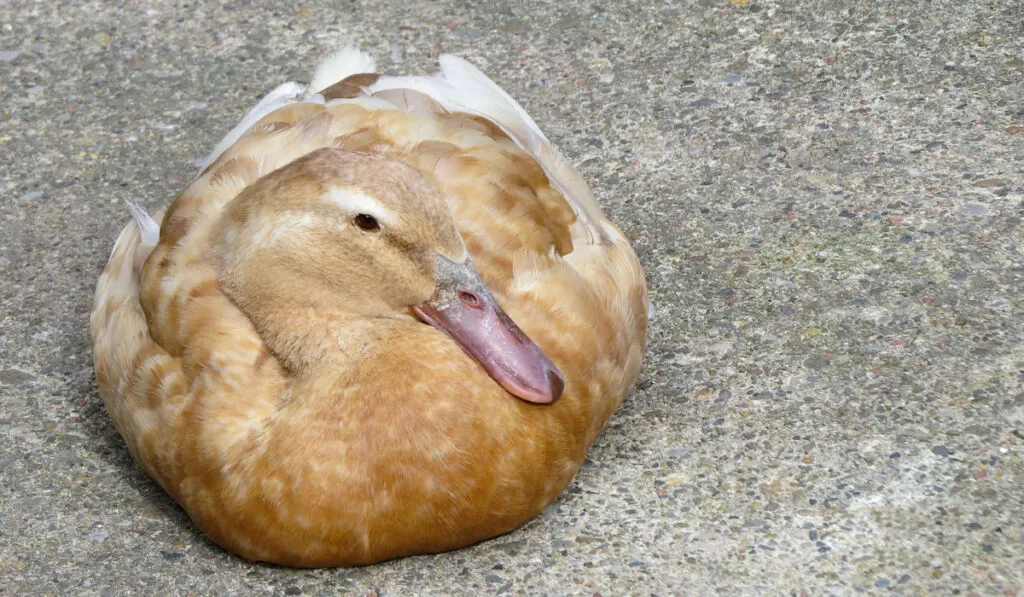
The Buff or Orpington duck is a medium-sized domestic duck weighing 6-8 pounds (3-3.7 kgs). Although it comes in various colors, brown is the most common. It has buff-colored feathers and orange-yellow feet and shanks.
The male Orpington has a yellow bill and a darker brown head and neck. On the other hand, the female counterpart has a brownish-orange bill and a lighter brown head and neck.
Generally, they both have long bodies, a deep and broad carriage, and the brown plumage has a reddish undertone.
The Orpington breed offers much if you are looking for a dual-purpose, attractive duck. On average, they lay 150-220 eggs annually and gain weight rapidly within 8-10 weeks. Thus, they are market ready within a short period.
Buff ducks are friendly and excellent foragers. So, look no further than an Orpington if you’re searching for a beautiful dual-purpose brown duck breed.
4. Hooked Bill
The Hooked Bill, also known as the Dutch Hookbill, is a distinctive duck breed.
The Hooked Bill duck has an elongated beak that curves downwards, giving them a hooked appearance that sets them apart from other duck breeds. It’s one of the rarest domesticated duck breeds and can be traced back over 400 years.
The Hooked Bill ducks are friendly, docile, and efficient layers. They are thus great farm companions. Males are quieter than females, and you can quickly tell them apart.
They lay an average of 100-225 eggs annually. Therefore, if you are looking for an exciting and unique duck breed, the Hooked Bill is your ideal choice.
5. Welsh Harlequin
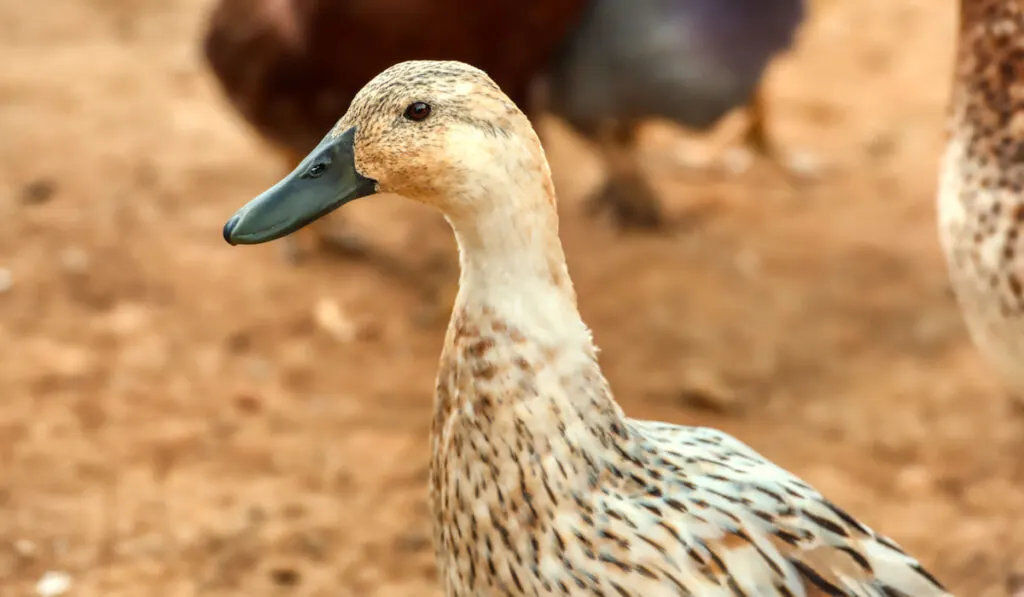
The Welsh Harlequin is a valuable, lightweight duck breed weighing 5-5.5 pounds (2.3 -2.5 kgs).
They have streamlined bodies with rounded chests, medium-width backs, and wide-spaced legs.
Most people breed Harlequins for their unique features. They are adaptable, active foragers and incredible egg and lean meat producers. On average, they lay 160-190 eggs annually.
To choose an authentic breed, avoid Harlequin ducks with the following characteristics:
- Light-colored bills
- Short and blocky bodies
- More than half below or above the typical body weight
Their quiet, curious, and social attributes make them a great fit to add to your other breeds.
6. Northern Pintail
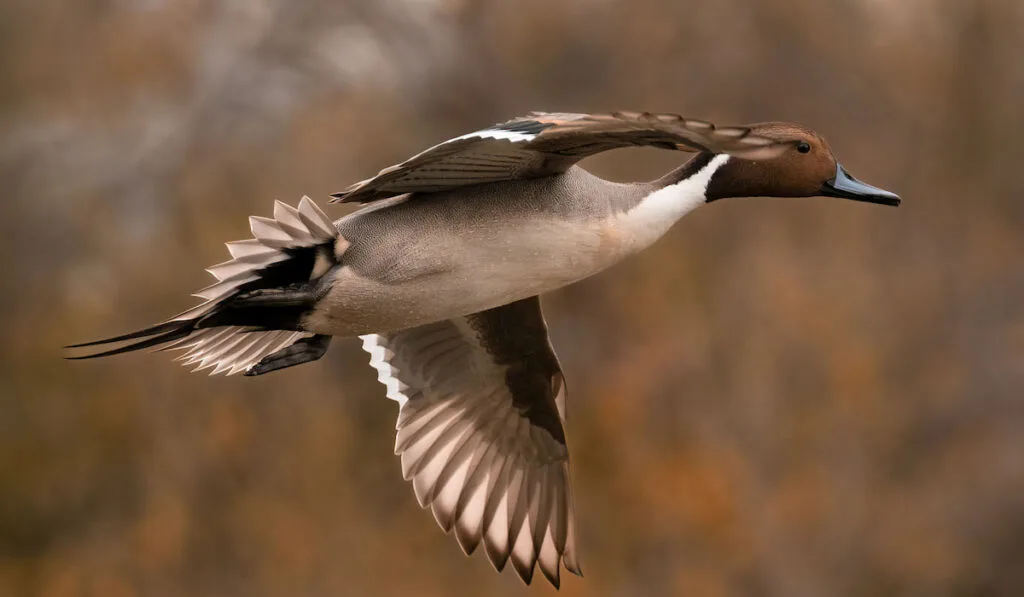
The Nothern Pintail duck has a long slender body with long and narrow wings. They are 20-30 inches (50.8-76.2cm) long and weigh 1-3 pounds (0.5-1.5kg). This breed is nicknamed “greyhound of the air.”
Pointed and long central tail feathers characterize these birds, hence their name. The males have a brown head, white breasts, and white stripes on each side of the neck. The back is blackish gray.
On the other hand, the female has a tan head and neck and brown feathers on the back. The breed’s population has drastically declined and is now under government protection.
Climate change and modern farming practices have affected their habitats, thus contributing to the decline.
7. Mallard
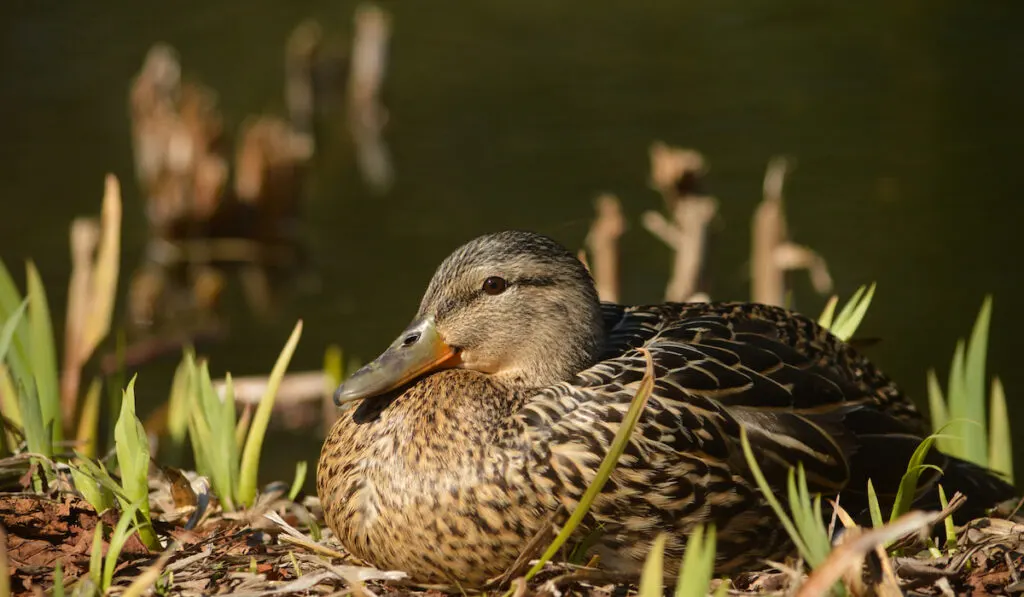
The Mallard is one of North America’s most popular domesticated duck breeds.
They are approximately 20-28 inches (50.8-71cm) in length and weigh about 2.9 pounds (1.3 kg).
During breeding seasons, the males have beautiful plumage to attract the females. Mallard males have a green head, yellow bill, white neck ring, chestnut brown chest, and brown back. They also have black-white tail curls that give them a unique appearance.
In contrast, the Mallard female is mottled brown. The head is a light tan, with dark brown stripes near the crown and eyes. The bill is orange with dark markings, and the feet and legs are orange.
A yellowish bill is the only feature that distinguishes non-breeding male Mallards from females.
8. American Wigeon
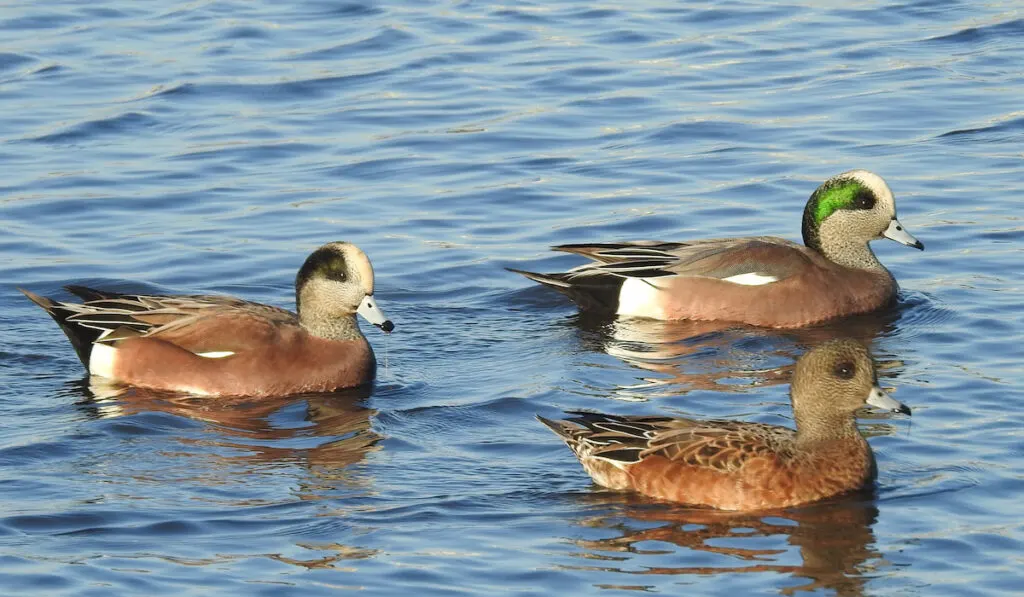
The American Wigeon is a medium-sized duck breed weighing approximately 2.2 pounds (1.01 kg). It has a length of up to 13.8 inches (35 cm). They also have a pinkish-brown breast, and the white patch on the upper wing is diagnostic when in flight.
American Wigeons are round-headed and have short, bluish-gray, black-tipped bills. Females and non-breeding males have a gray head, brownish crown and chest, and a dark mark around the eye. The feet and legs are blue gray to dark gray.
A pale cinnamon body with black undertail feathers and white patched sides distinguish breeding males.
Moreover, it’s a wary bird and takes flight when disturbed. But their loud, distinctive whistles clearly identify American Widgeons among a group of mixed ducks on a pond.
Fun fact: American Wigeons love sitting on the water with pulled-down heads. You might think they are neckless!
9. Ruddy Duck
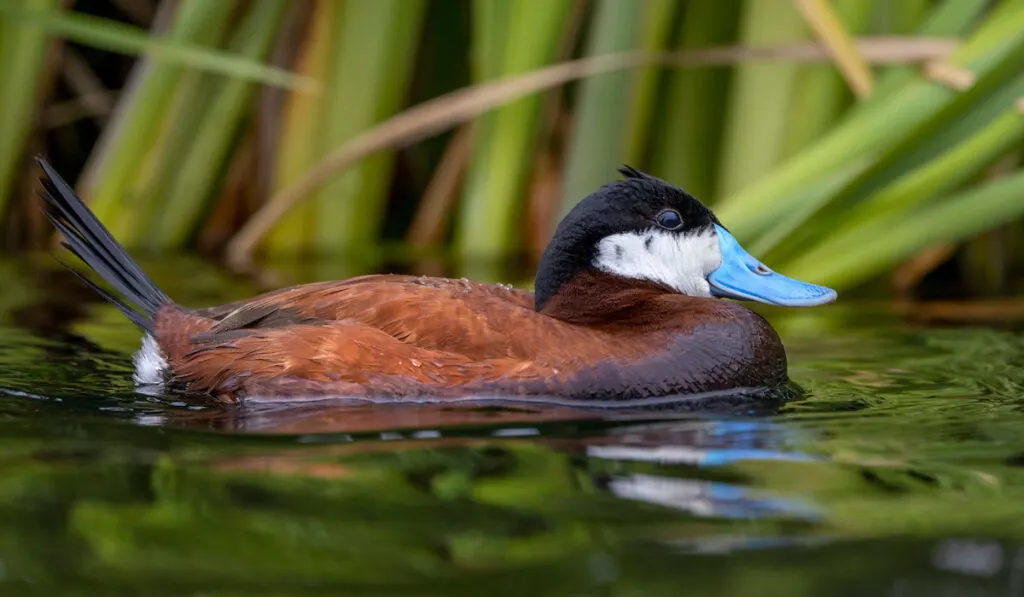
Ruddy ducks are compact and stiff-tailed with chunky bodies and stubby wings. They use their stiff tail to hold them upwards, allowing them to see far. They weigh between 0.6-1.8 pounds (300-800 g) and have a length of 13.8 -17 inches (35-43 cm).
Male and female ruddy ducks are distinctive in appearance; males change their features depending on the season. In winter, the males have rich chestnut bodies, necks, and bright blue bills.
Ruddy ducks hold their crown, tail, and nape feathers erect. This is perhaps their most unique distinguishing feature.
10. Northern Shoveler
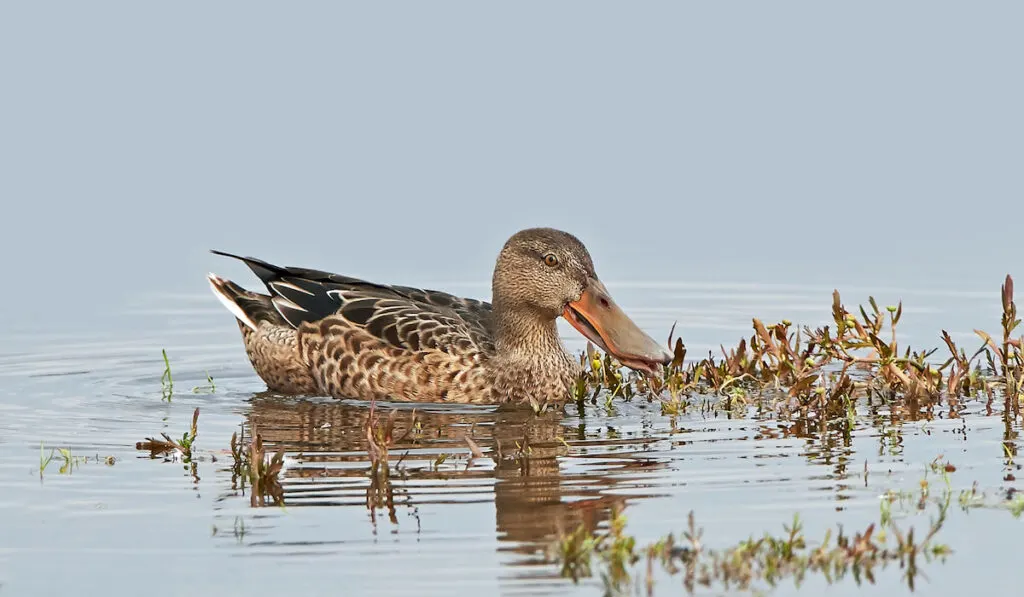
With its large spoon-shaped bill, the Nothern Shoveler could be the most peculiar dabbling duck breed.
If the outstanding bill doesn’t catch your eye, the male’s plumage will. The bill has comb-like edges that help extract seeds and minute crustaceans from the water.
Male Shovelers have green iridescent heads and necks, chestnut bellies, white breasts, and rusty sides. Females have mottled brown plumage and long, broad olive-green bills.
These ducks weigh approximately 1.3 pounds (600 grams) and are an average 18.9 inches (48 centimeters) in length.
11. Gadwall
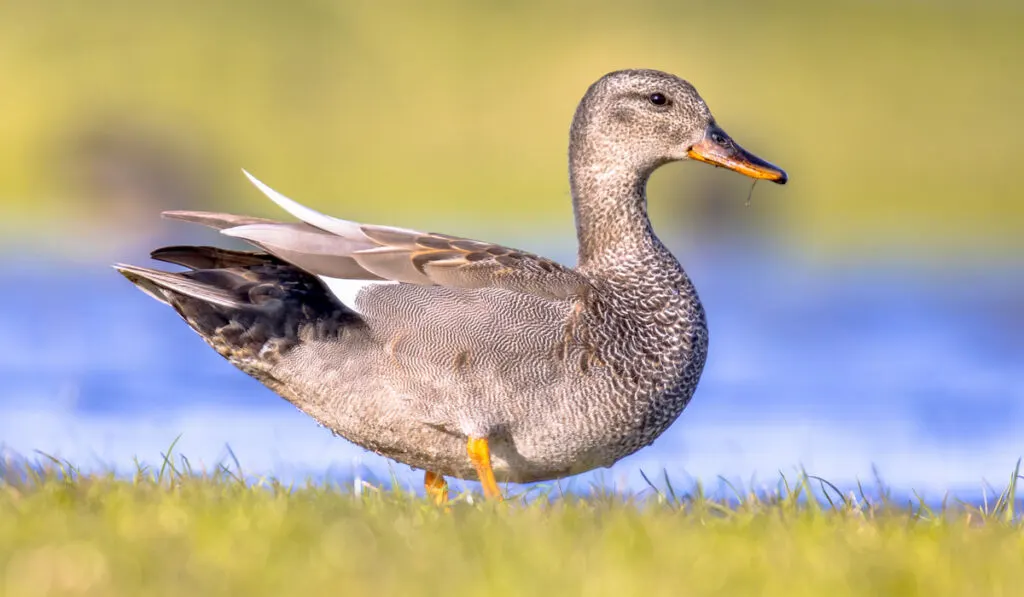
The Gadwall is a medium-sized duck with unremarkable gray-brown coloring. They weigh approximately 2 pounds (0.9 kg) and have an average length of 21 inches (53 centimeters).
The male Gadwalls have a gray-brown color, a black rump, and a white belly. In addition, a small white patch is visible when in flight. Female Gadwalls are mottled brown and are often mistaken for female Mallards.
However, they have a thinner bill, a white wing patch in flight, a plain face, and an orange line on the edge of the bill. Often, you will find the Gadwalls in small flocks or pairs in shallow wetlands, bays, or ponds.
Final Thoughts
There are a variety of brown duck breeds, each with unique features and purposes. Whether you’re looking for a brown duck to keep as a pet or want to learn more about brown ducks, there’s certainly a suitable duck breed for you. Which among the above brown duck breeds is your favorite?
Resources
- https://www.allaboutbirds.org/news/simple-steps-for-identifying-confusing-brown-ducks-females-and-otherwise/
- https://nhpbs.org/wild/mallard.asp
- https://www.projectnoah.org/spottings/10524621
- https://www.poultryclub.org/breeds/ducks/ducks-light/campbell/
- https://livestockconservancy.org/heritage-breeds/heritage-breeds-list/khaki-campbell-duck/
- https://livestockconservancy.org/heritage-breeds/heritage-breeds-list/buff-orpington-duck/
- https://cosleyzoo.org/orpington-duck/
- https://livestockconservancy.org/heritage-breeds/heritage-breeds-list/dutch-hookbill-duck/
- https://www.poultryhub.org/all-about-poultry/species/fancy-duck-breeds/welsh-harlequin
- https://livestockconservancy.org/heritage-breeds/heritage-breeds-list/welsh-harlequin-duck/
- https://www.ducks.org/hunting/waterfowl-id/northern-pintail
- https://nhpbs.org/natureworks/northernpintail.htm
- https://www.nwf.org/Educational-Resources/Wildlife-Guide/Birds/Mallard
- https://seaworld.org/animals/facts/birds/american-wigeon/
- https://www.allaboutbirds.org/guide/American_Wigeon/id
- http://www.biokids.umich.edu/critters/Oxyura_jamaicensis/
- https://animalia.bio/northern-shoveler
- https://www.allaboutbirds.org/guide/Northern_Shoveler/overview#
- https://www.ducks.org/hunting/waterfowl-id/gadwall
